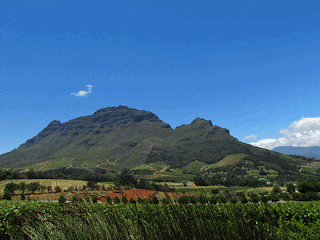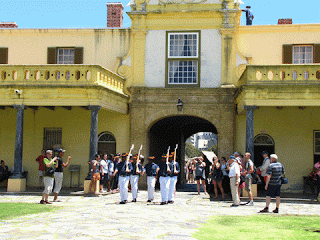We spent our last day in Cape Town exploring the town itself, taking a
bus to the town centre. We started at the Castle of Good Hope and were
just in time for the tour with our guide telling us all about the
history of this star-shaped fortress. It was built in the late 1600s and
is the oldest surviving colonial building in South Africa. When we
finished our tour there was the key ceremony to watch and the firing of
the little signal cannon.
From here we began our walk around town taking in the old colonial style
buildings from several eras. Eventually we climbed up to the
picturesque Malay Quarter on Signal Hill called the Bo-Kaap. Here boxy
houses with flat roofs are painted riotous colours, giving this area a
jolly feel. It may only be a façade, but it certainly attracts the
tourists to a mostly otherwise unremarkable suburb.
 |
| Flower market |
The walk took us down to Greenmarket Square and the stalls selling
articles from all over Africa - textiles, carvings, etc. On the way we
passed some NOLA French Quarter style houses with wrought iron
balconies. There is such a mix of styles here in Cape Town - very
interesting.
Feeling in need of refreshment, we walked back up onto Bree Street to
the Cape Heritage Hotel where we had a light lunch in the sunlit
courtyard. Here they have completed a huge renovation project, which
looks wonderful, complete with the oldest producing table grapevine in
South Africa that survived near obliteration with the disrepair followed
by the restoration of the hotel.


Our next stop was to see one of the old family houses that has been preserved. We had to ring the doorbell to be let in, then more or less had the place to ourselves. No photos allowed, but it was interesting to see how the old colonials lived here. And so we walked back towards the hotel, all the while watching the fantastic clouds pouring over Table Mountain. No wonder they call this the 'tablecloth', the clouds shrouded the mountain in an ever moving sheet of clouds - very impressive. We were so glad to have made our visit on such a clear day!

By the time we got back to the V&A Waterfront, there was quite a gale blowing, so tonight we opted for eating in the hotel and weren't disappointed. As we waited for a table (a large party had arrived just ahead of us and we were advised to have a drink in the bar while they got themselves organised), we were introduced to the special South African wine, Blanc de Noir. This is a delicate pale cherry coloured wine created by leaving the whole red grape in the crushed juice for some time to give it colour, then the skins are removed and the wine made. It's so good they keep it all to themselves, none going for export, apparently. We did enjoy our tasting glass before dinner! Dinner was also excellent, with beautifully prepared dishes that we relished as we watched the wind creating havoc as people walked along the quayside.



































































